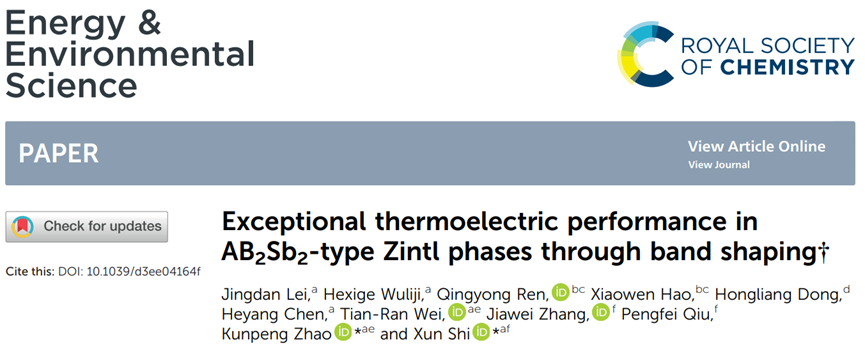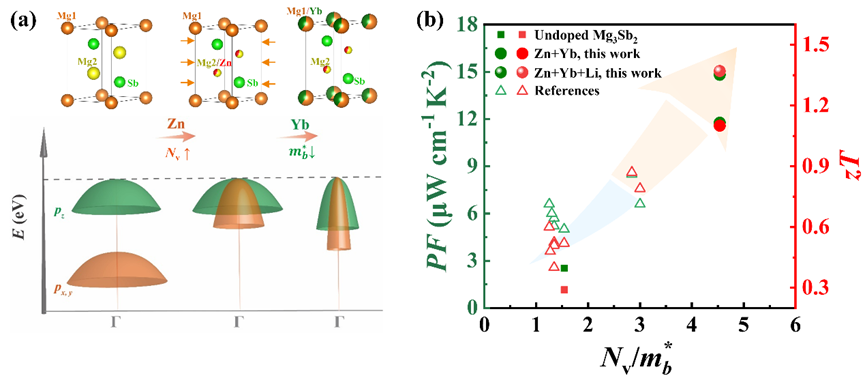Recently, the research team from Shanghai Jiao Tong University, cooperated with the scientists from Dongguan Spallation Neutron Source Science Center and Shanghai Center for High Pressure Science and Technology Advanced Research, made important new progress in the band structure modularization and performance optimization of AB2Sb2 based thermoelectric materials. Relevant results have been published in the journal of Energy & Environmental Science entitled “Exceptional thermoelectric performance in AB2Sb2-type Zintl phases through band shaping” (DOI: 10.1039/d3ee04164f).

Thermoelectric (TE) technology is capable of directly converting thermal energy into electrical energy, or vice versa, which allows for accurate, reliable, and static thermoelectric generation and electronic refrigeration. An excellent TE material should simultaneously have a high Seebeck coefficient S (sustaining high voltage output), a large electrical conductivity σ (diminishing Joule heat), and a low thermal conductivity κ (maintaining temperature difference). However, these parameters are strongly correlated with each other through the material’s Fermi level and band structure, making it arduous to improve the zT value. The term S2σ, called as power factor PF, is related to the electrical properties. PF is related to the band degeneracy (Nv) and band effective mass ( through PF ∝ Nv/ for isotropic band. A high band degeneracy (Nv) can facilitate electron transport through multiple conducting channels, making it one of the most successful approaches for improving electrical properties.
This work proposes a novel band shaping engineering to considerably optimize the electrical transports of p-type AB2Sb2-based materials. The strategy contains the processes of band edge overlapping and sharping, which can be respectively realized through alloying Zn at the Mg2 sites for doubled band degeneracy and alloying Yb at the Mg1 sites of Mg3Sb2 for decreased band effective mass. In combination with optimized carrier concentration by Li doping, the maximum power factor and zT values are finally promoted to 15.9 μW cm-1 K-2 and 1.4, respectively. These results demonstrate that band edge shaping is very successful for the optimization of electrical transports and thermoelectric performance in semiconductors.
This work was supported by the National Natural Science Foundation of China and Shanghai Government.
The paper link is as follows: https://doi.org/10.1039/D3EE04164F

Figure 1. Band structure and TE performance of p-type Mg3Sb2-based materials. (a) Schematic diagram of the crystal structure and the valence band structure near Γ point. (b) Thermoelectric power factor PF and figure of merit zT versus Nv/ at 773 K for p-type Mg3Sb2-based materials.

Figure 2. The band structures for (a) Mg12-2nZn2nSb8, and (c) Mg12-3nZn2nYbnSb8 (n = 0, 1, 2, 3, 4) calculated by the mBJ + SOC method. (b) Atom-projected density of states (DOS) of the valence band for Mg12Sb8. (d) Crystal field splitting energy Δ, (e) effective mass of the valance band edges (VB1 or VB2), and (f) energy difference between CBM and VBM (ECBM-EVBM) as a function of the alloying content n.

Figure 3. (a) The length of interlayer (d1) and intralayer (d2 and d3) Sb-Sb bonds as a function of x. The inset illustrates three different Sb-Sb bonding in the crystal structure. (b) Integrated projected crystal orbital Hamilton population (IpCOHP) of the three Sb–Sb bonding for pristine Mg3Sb2, Zn-doped Mg3Sb2, and Zn/Yb co-doped Mg3Sb2. (c) Room temperature carrier mobility m as a function of x for Mg3-2xZn2xSb2 (x = 0, 0.4, 0.6, 0.7), Mg3-3xZn2xYbxSb2 (x = 0.4, 0.5, 0.6, 0.7, 0.8), and Mg0.9-yLiyZn1.4Yb0.7Sb2 (y = 0.003, 0.005). The dashed lines are guide to the eyes. The inset shows the calculated DOS effective mass based on the SPB model. (d) Temperature dependent figure of merit zT.
Author: Jingdan Lei
